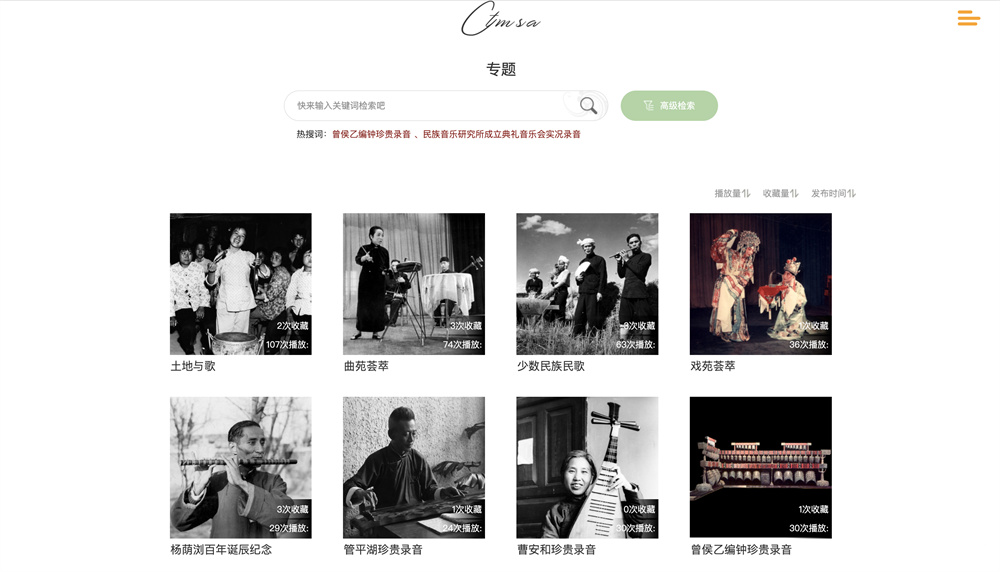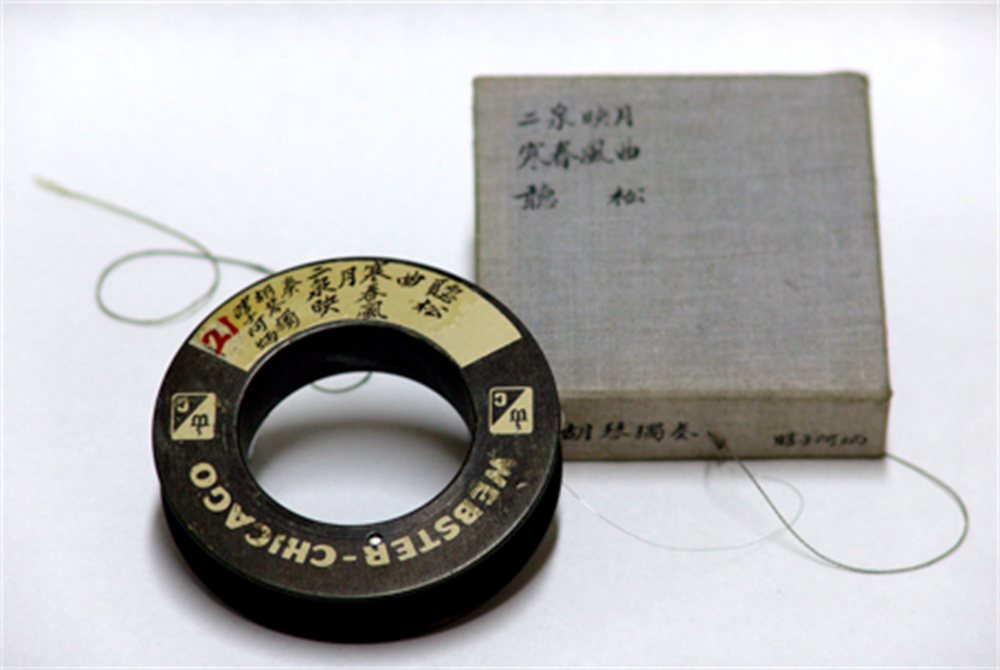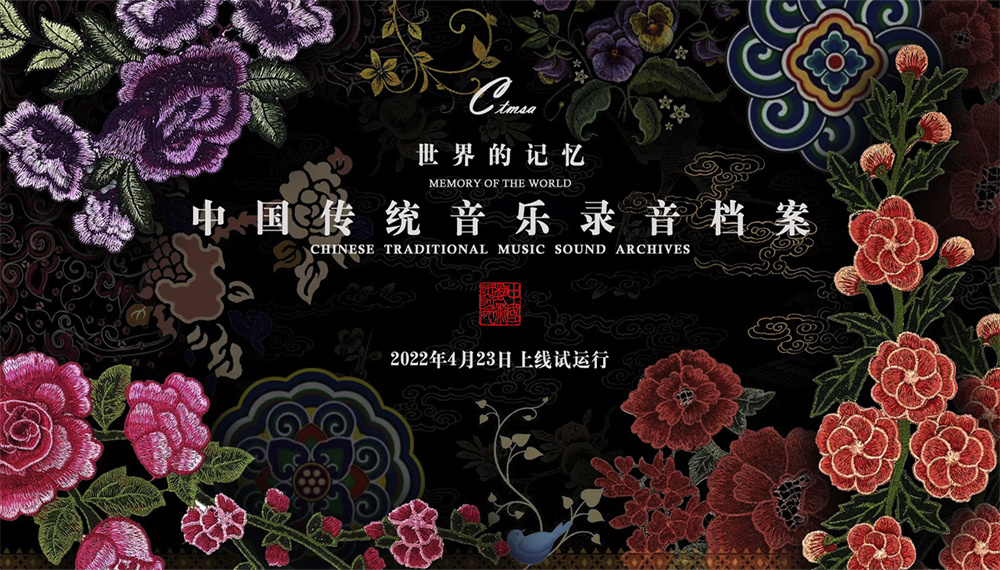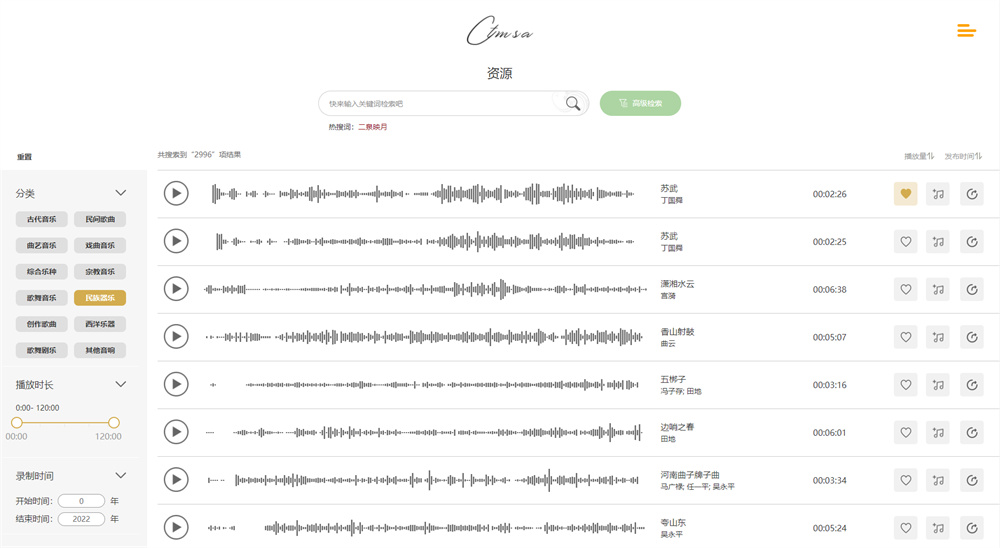
The erhu piece "Erquan Reflecting the Moon" played by A Bing himself, the guqin piece "Fengming Chaoyang" recorded by Ma Zhumei at the age of 89, the "Quick Drum Duan" recorded in 1956 by Zhu Qinfu, a famous Sunan wind and percussionist, "Jasmine" sung by Xiu Rong...
On April 23, World Book Day, the digital platform ( https://www.ctmsa-cnaa.com ) collected and constructed by the China National Academy of Arts, "Memory of the World - Chinese Traditional Music Recording Archives" was officially launched for trial operation. The first batch of about 10,000 pieces of audio data was released. Opening the digital platform is like entering a treasure trove of Chinese music history, where precious audio materials played and sung by old artists are readily available.
It took more than half a century to collect, covering almost all provinces and regions
Since 1950, a group of musicologists, represented by Yang Yinliu and Cao Anhe, began to systematically conduct field investigations and data collection on traditional Chinese music. For more than half a century, scholars from the Music Institute of the China Academy of Arts have traveled all over the country, collecting a large number of precious materials of endangered traditional music, including A Bing's "Erquan Reflecting the Moon", many of which have become the "extreme sound of Chinese traditional music". ", has irreplaceable artistic and academic value.
The "Memory of the World Register" is an important part of the UNESCO "Memory of the World Project" project. Among the three major cultural heritage protection projects of UNESCO, the document heritage and the listed in the "Memory of the World Register" Tangible cultural heritage and intangible cultural heritage listed in the World Heritage List and the Intangible Cultural Heritage of Humanity are of equal value. At present, 13 cultural heritage items in my country have been included in the list, including the original manuscript of the "Dongba Ancient Books" of the Naxi people, the "Compendium of Materia Medica", "The Yellow Emperor's Internal Classic", the official archives of the Yuan Dynasty in Tibet, the archives of the Nanjing Massacre, and Oracle bone inscriptions.
For the "Recording Archives of Chinese Traditional Music", the reason given by the International Advisory Committee of the "Memory of the World" project is: "The Recording Archives of Traditional Chinese Music is the result of systematic field recordings in almost all provinces and regions in China for several years, covering The traditional music of more than 50 ethnic groups or cultural groups. The musical heritage of ancient China is usually passed down by word of mouth, and these recordings have allowed ancient Chinese music to be passed down through generations.”
After the project was selected, the China National Academy of Arts organized a special team to use international standards to digitally rescue and protect different types of analog carriers such as records (coarse and dense), steel wire tapes, open-reel tapes, and cassette tapes. After more than 20 years of hard work, it has finally formed a professional database with the largest number of recordings of Chinese traditional music, the longest history and the highest value in China.
It is reported that the digital platform of Chinese traditional music recording archives is put into trial operation today. About 10,000 pieces of audio data will be released in advance, and then all the tracks of these precious audio archives will be released one after another.
10 categories display 10,000 precious audio materials
The digital platform of "Chinese Traditional Music Recording Archives" is designed and constructed by the Art and Documentation Museum of the China National Academy of Arts, and the academic resources published have been reviewed by experts from the Music Research Institute.
On the first day of the launch, the surging journalists opened the digital platform of "Chinese Traditional Music Recording Archives". The dynamic welcome page of the platform consists of traditional ethnic embroidery and flower patterns to form an image of "Blossoming Flowers Like a Brocade". , to bring forth the new" concept.
Entering the resource theme, the platform has set up 10 categories of ancient music, folk songs, folk music, opera music, comprehensive music, religious music, song and dance music, national instrumental music, creative songs, Western musical instruments, song and dance music, and other audio.
A Bing's erhu song "Erquan Reflecting the Moon", the Guqin song "Fengming Chaoyang" recorded by Ma Zhumei at the age of 89, the Jiangsu tenth drum "Quick Drum Duan" recorded in 1956 by Zhu Qinfu, a famous Sunan wind and percussionist, Shan Xiurong Singing "Jasmine"... Open the resource library, and the precious original audio materials are everywhere.
Different from the music records that everyone often listens to, many of the audio materials recorded on the digital platform of traditional Chinese music recording archives have poor sound quality and are mixed with rough ambient background sounds.
The China Academy of Arts explained that this is because the resources provided by the platform are academic materials collected and collected by scholars, most of which are collected from field visits. Due to the performance of the early analog recording equipment and the natural environment during recording, it is difficult for the quality of some audios to meet the modern recording standards.
In addition, the digital platform of "Chinese Traditional Music Recording Archives" is different from general music digital platforms. It has a prominent academic nature. The platform is based on the principle of providing first-hand academic materials, so the original form of the resources is preserved as much as possible, and the digital audio After any post-processing, both audio and bibliographic information are presented in their original form. Due to the long time span and the large number of people who handled it, the original information description of some audios is not complete, and this release is presented in its original form.
"Unlike other forms of cultural heritage, the core value of audio files, in addition to the external transmission form, is the recorded audio content. Therefore, the protection of audio files is more difficult, and it is necessary to protect and manage It is a good original carrier, and it must be digitally extracted scientifically and accurately to restore the sound content recorded by it." Han Ziyong, President of the Chinese Academy of Arts, in his speech at the platform's online release ceremony, reviewed the collection of traditional music recording archives by the Chinese Academy of Arts. The efforts made in the rescue and protection of , sorting, digitalization, and the far-reaching significance of the digital platform construction of the "Chinese Traditional Music Recording Archives" are discussed from the perspectives of document archives heritage and intangible cultural heritage.
"This platform brings together traditional music resources from cultural groups of all ethnic groups and regions in my country, and is the best embodiment of the diverse, integrated and long-standing Chinese music culture. It presents the historical recording methods and academic concepts of traditional music by senior scholars. It can provide useful experience for the recording and protection of the current music intangible cultural heritage." Han Ziyong pointed out that as China's first "Memory of the World" project protection unit, the China National Academy of Arts has pioneered the use of digital technology. To release this cultural heritage to the society and share it with the world will further promote the protection and utilization of traditional Chinese cultural heritage, demonstrate cultural confidence, and promote the implementation of the people-centered concept advocated by General Secretary Xi Jinping and the instructions to make cultural heritage come alive.
"Let's open this colorful audiobook on World Book Day, follow the footsteps of academic sages, explore and listen to the thousands of traditional music bred by the vast land of China, and feel and appreciate the traditional culture brought to us. Deep power and shock in the depths of the soul." Han Ziyong said.
The event was hosted by the China National Academy of Arts, and undertaken by the Art and Documentation Museum, the Music Research Institute, and the Information Center of the China National Academy of Arts. Affected by the epidemic, the launch event was held online.
On April 23, World Book Day, the digital platform ( https://www.ctmsa-cnaa.com ) collected and constructed by the China National Academy of Arts, "Memory of the World - Chinese Traditional Music Recording Archives" was officially launched for trial operation. The first batch of about 10,000 pieces of audio data was released. Opening the digital platform is like entering a treasure trove of Chinese music history, where precious audio materials played and sung by old artists are readily available.

"Memory of the World - Archives of Chinese Traditional Music Recordings" digital platform special page.
It is reported that the audio materials included in the "Chinese Traditional Music Recording Archives" data platform come from the Chinese traditional music recording archives collected by the China National Academy of Arts. In the mid-1990s, this batch of important recordings attracted the attention of UNESCO and was included in the first batch of "Memory of the World Register".It took more than half a century to collect, covering almost all provinces and regions
Since 1950, a group of musicologists, represented by Yang Yinliu and Cao Anhe, began to systematically conduct field investigations and data collection on traditional Chinese music. For more than half a century, scholars from the Music Institute of the China Academy of Arts have traveled all over the country, collecting a large number of precious materials of endangered traditional music, including A Bing's "Erquan Reflecting the Moon", many of which have become the "extreme sound of Chinese traditional music". ", has irreplaceable artistic and academic value.

Yang Yinliu recorded A Bing's six handed down music on wire tapes.
In 1997, the Chinese traditional music recording archives collected by the China National Academy of Arts were selected into the UNESCO "Memory of the World" project and included in the first batch of "Memory of the World List". This is the first precious file selected in China and the first audio file selected in the world.The "Memory of the World Register" is an important part of the UNESCO "Memory of the World Project" project. Among the three major cultural heritage protection projects of UNESCO, the document heritage and the listed in the "Memory of the World Register" Tangible cultural heritage and intangible cultural heritage listed in the World Heritage List and the Intangible Cultural Heritage of Humanity are of equal value. At present, 13 cultural heritage items in my country have been included in the list, including the original manuscript of the "Dongba Ancient Books" of the Naxi people, the "Compendium of Materia Medica", "The Yellow Emperor's Internal Classic", the official archives of the Yuan Dynasty in Tibet, the archives of the Nanjing Massacre, and Oracle bone inscriptions.
For the "Recording Archives of Chinese Traditional Music", the reason given by the International Advisory Committee of the "Memory of the World" project is: "The Recording Archives of Traditional Chinese Music is the result of systematic field recordings in almost all provinces and regions in China for several years, covering The traditional music of more than 50 ethnic groups or cultural groups. The musical heritage of ancient China is usually passed down by word of mouth, and these recordings have allowed ancient Chinese music to be passed down through generations.”
After the project was selected, the China National Academy of Arts organized a special team to use international standards to digitally rescue and protect different types of analog carriers such as records (coarse and dense), steel wire tapes, open-reel tapes, and cassette tapes. After more than 20 years of hard work, it has finally formed a professional database with the largest number of recordings of Chinese traditional music, the longest history and the highest value in China.
It is reported that the digital platform of Chinese traditional music recording archives is put into trial operation today. About 10,000 pieces of audio data will be released in advance, and then all the tracks of these precious audio archives will be released one after another.
10 categories display 10,000 precious audio materials
The digital platform of "Chinese Traditional Music Recording Archives" is designed and constructed by the Art and Documentation Museum of the China National Academy of Arts, and the academic resources published have been reviewed by experts from the Music Research Institute.
On the first day of the launch, the surging journalists opened the digital platform of "Chinese Traditional Music Recording Archives". The dynamic welcome page of the platform consists of traditional ethnic embroidery and flower patterns to form an image of "Blossoming Flowers Like a Brocade". , to bring forth the new" concept.

Platform Home
The platform displays and publishes in an all-round way through "resources", "topics" and "columns". "Resources" is the core of the platform, and its classification is based on the book "The Catalogue of Chinese Music and Audio Collected by the Music Institute of the Chinese Academy of Arts" edited and published by the Music Research Institute and prefaced by Huang Xiangpeng. In order to meet the resource needs of different groups, the platform is designed with a variety of retrieval methods, providing multiple retrieval and screening conditions, and related conditions are used alternately, striving to achieve precise positioning of resources. "Topics" is the systematization and thematicization of resource information, which is organized and extracted according to important music academic matters. The "Column" provides academic writings related to the resource, deepens the resource from a theoretical perspective, and helps visitors better understand the meaning and value of the resource.Entering the resource theme, the platform has set up 10 categories of ancient music, folk songs, folk music, opera music, comprehensive music, religious music, song and dance music, national instrumental music, creative songs, Western musical instruments, song and dance music, and other audio.
A Bing's erhu song "Erquan Reflecting the Moon", the Guqin song "Fengming Chaoyang" recorded by Ma Zhumei at the age of 89, the Jiangsu tenth drum "Quick Drum Duan" recorded in 1956 by Zhu Qinfu, a famous Sunan wind and percussionist, Shan Xiurong Singing "Jasmine"... Open the resource library, and the precious original audio materials are everywhere.

"Memory of the World - Archives of Chinese Traditional Music Recordings" digital platform resource page.
Retain the original state of resources to facilitate academic researchDifferent from the music records that everyone often listens to, many of the audio materials recorded on the digital platform of traditional Chinese music recording archives have poor sound quality and are mixed with rough ambient background sounds.
The China Academy of Arts explained that this is because the resources provided by the platform are academic materials collected and collected by scholars, most of which are collected from field visits. Due to the performance of the early analog recording equipment and the natural environment during recording, it is difficult for the quality of some audios to meet the modern recording standards.
In addition, the digital platform of "Chinese Traditional Music Recording Archives" is different from general music digital platforms. It has a prominent academic nature. The platform is based on the principle of providing first-hand academic materials, so the original form of the resources is preserved as much as possible, and the digital audio After any post-processing, both audio and bibliographic information are presented in their original form. Due to the long time span and the large number of people who handled it, the original information description of some audios is not complete, and this release is presented in its original form.
"Unlike other forms of cultural heritage, the core value of audio files, in addition to the external transmission form, is the recorded audio content. Therefore, the protection of audio files is more difficult, and it is necessary to protect and manage It is a good original carrier, and it must be digitally extracted scientifically and accurately to restore the sound content recorded by it." Han Ziyong, President of the Chinese Academy of Arts, in his speech at the platform's online release ceremony, reviewed the collection of traditional music recording archives by the Chinese Academy of Arts. The efforts made in the rescue and protection of , sorting, digitalization, and the far-reaching significance of the digital platform construction of the "Chinese Traditional Music Recording Archives" are discussed from the perspectives of document archives heritage and intangible cultural heritage.
"This platform brings together traditional music resources from cultural groups of all ethnic groups and regions in my country, and is the best embodiment of the diverse, integrated and long-standing Chinese music culture. It presents the historical recording methods and academic concepts of traditional music by senior scholars. It can provide useful experience for the recording and protection of the current music intangible cultural heritage." Han Ziyong pointed out that as China's first "Memory of the World" project protection unit, the China National Academy of Arts has pioneered the use of digital technology. To release this cultural heritage to the society and share it with the world will further promote the protection and utilization of traditional Chinese cultural heritage, demonstrate cultural confidence, and promote the implementation of the people-centered concept advocated by General Secretary Xi Jinping and the instructions to make cultural heritage come alive.
"Let's open this colorful audiobook on World Book Day, follow the footsteps of academic sages, explore and listen to the thousands of traditional music bred by the vast land of China, and feel and appreciate the traditional culture brought to us. Deep power and shock in the depths of the soul." Han Ziyong said.
The event was hosted by the China National Academy of Arts, and undertaken by the Art and Documentation Museum, the Music Research Institute, and the Information Center of the China National Academy of Arts. Affected by the epidemic, the launch event was held online.
Related Posts